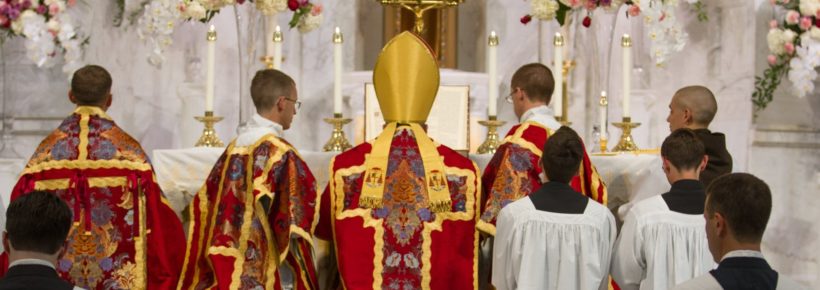We are facing an enormous and dramatic clash between good and evil, death and life, the “culture of death” and the “culture of life.” We find ourselves not only “faced with” but necessarily “in the midst of” this conflict: we are all involved and we all share in it, with the inescapable responsibility of choosing to be unconditionally pro-life. ─ Pope St. John Paul II, encyclical Evangelium Vitae [“The Gospel of Life”], March 25, 1995, ¶28.
Have you ever heard the phrase “Culture of Life”?
Have you ever wondered what it meant? What is its origin? What is its counterpart, the Culture of Death, and how does that play into our world today? How do we promote a Culture of Life? And how do we form (or reform) our own lives so that we can authentically live it?
Pope St. John Paul II coined the phrase, “Culture of Life.” His first written reference to the term was in his 1991 encyclical Centesimus Annus [¶39]. He expanded greatly on this concept in Evangelium Vitae, the 1995 encyclical often referred to as the “Charter of the pro-life movement.”
Since then, many Catholics (even those only tangentially aware of social trends) have heard the term “Culture of Life.” But most may not realize that it applies directly to them.
The purpose of this article is to clarify for each Catholic ─ and, indeed, for every human being ─ the necessity of supporting a Culture of Life with everything we do, everything we say, and everything we think.

“ADAMELLO – PAPA – Giovanni Paolo II – Papa Giovanni Paolo II celebra la Santa Messa davanti all’altare costruito sulle cime dell’ Adamello, il 16 luglio 1988” by Gregorini Demetrio is licensed under CC BY 4.0 / cropped from original
Catholic Social Teaching Upholds the Dignity of Each Human Person
To properly understand the term “Culture of Life,” we must first understand the natural dignity of the human person.
What makes a human being “special?” Why should we regard a human person differently from any other of God’s millions of different species of living creations?
From the time we were young, we instinctively knew the answer to this question: “The dignity of the human person is rooted in his creation in the image and likeness of God; it is fulfilled in his vocation to divine beatitude” [Catechism of the Catholic Church, ¶1700].
Dignity is the state or quality of being worthy of honor or respect. Human dignity derives from the distinctive ability of the human species to reason, to think, to contemplate.
Human persons have an inherent and immeasurable worth and dignity. Endowed with a spiritual and immortal soul, intelligence and free will, the human person is ordered to God and called in soul and in body to eternal beatitude.
No other species possesses this distinction.
Only the human soul is eternal. Only the human soul is sacred; “You are holy, for you are God’s temple and God dwells in you” [1 Corinthians 3:16].
In a very real sense, God shared the core of His being ─ His divinity ─ with us. Gaudium et Spes [¶22] explains that “For, by his Incarnation, He, the son of God, in a certain way united Himself with each man. He worked with human hands, He thought with a human mind. He acted with a human will, and with a human heart He loved. Born of the Virgin Mary, He has truly been made one of us, like to us in all things except sin, He, the Redeemer of man.”
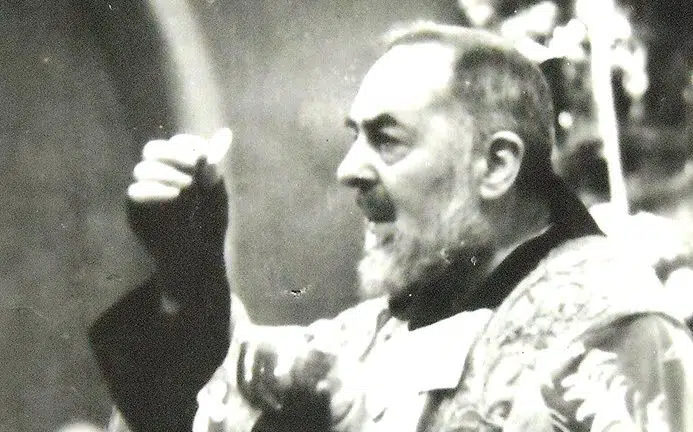
St. Padre Pio, priest and stigmatist, bled during the consecration of the Mass. We must never receive Our Lord unworthily.
Sin offends human dignity, but sin cannot cancel or reduce it. It may be difficult to accept, but even the career criminal who is a predator and murderer must be treated with respect.
What is the Culture of Life?
If we fully understand the nature of human dignity, it will inform our thinking about how people live between the beginning and end of their lives as well.
But what does this even mean? We can begin by answering this question: What kind of world do we want for ourselves and for our children?
We long for a world free from evil. There are three types of evil, which a Culture of Life opposes:
- Physical evil: including sickness, injury, oppression and poverty, lack of education and failure to fulfill one’s potential.
- Mental evil: including emotions which disturb the peace of the person and inflict suffering.
- Moral evil: defined as acting, speaking or thinking in a manner contrary to the will of God.1
A Culture of Life seeks to eliminate these evils, treating each individual with the respect he or she inherently deserves.
Gaudium et Spes offers examples of lifestyles and actions that oppose human dignity. This encyclical says, “Whatever insults human dignity, such as subhuman living conditions, arbitrary imprisonment, deportation, slavery, prostitution, the selling of women and children; as well as disgraceful working conditions, where men are treated as mere tools for profit, rather than as free and responsible persons; all these things and others of their like are infamies indeed.” [¶27].
Every person is particularly called to respect and care for those who are helpless or in great need, from the preborn child to the comatose or sick elderly [Luke 10:25-37].
Only when the world is free from evil will we have true peace.
What is the Culture of Death?
Opposed to the Culture of Life is the Culture of Death. The core influences of the Culture of Death assault our Faith, human life, or family. These include contraception, abortion, LGBTQ “marriage,” and euthanasia.
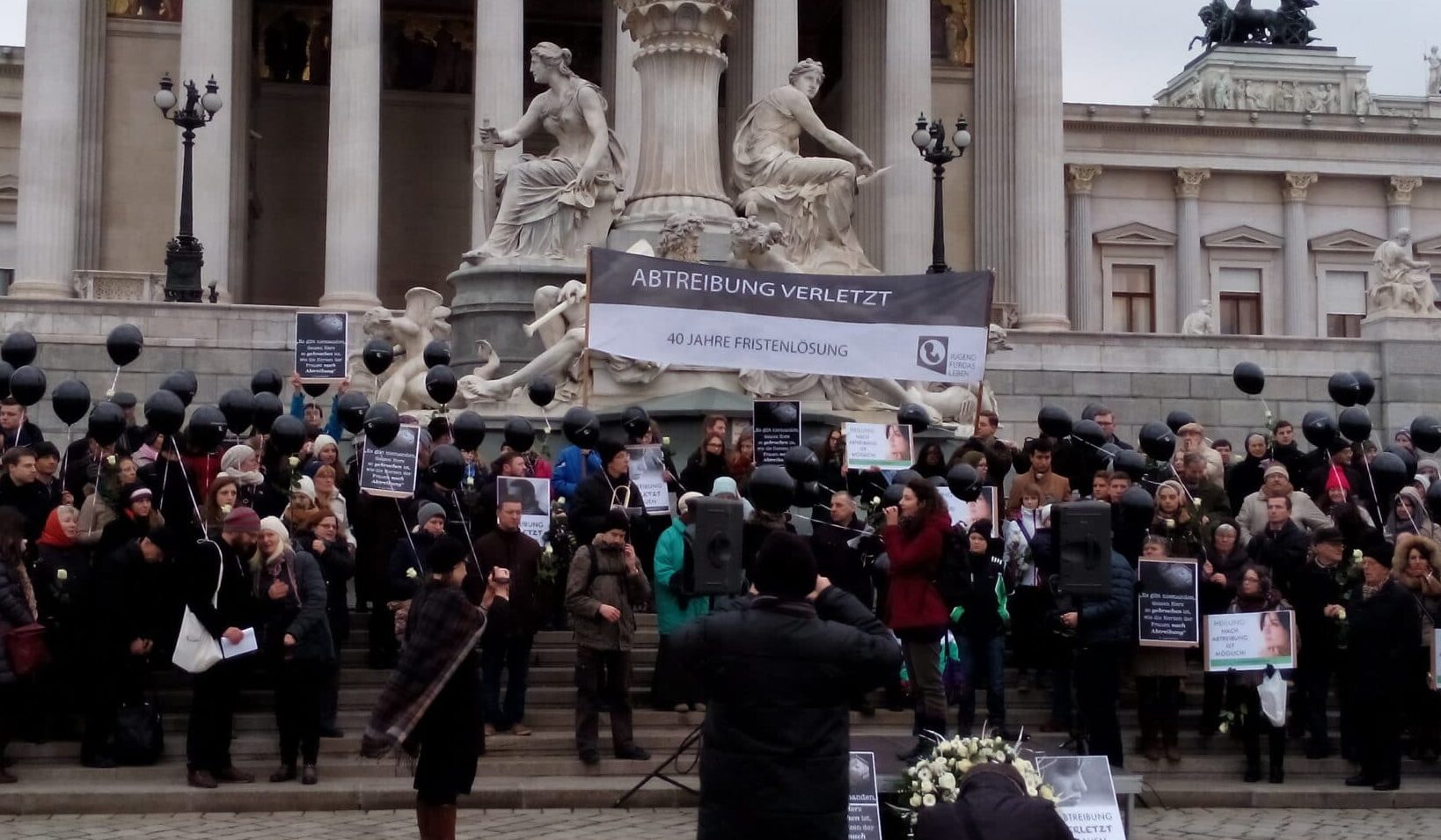
Austrians’ activism exposes the reality of anti-life policies and practices indicative of the Culture of Death.
The Church rejects these personal actions because they have one thing in common — they are violations and abasements of the inherent dignity of the human person.
This is why Catholic social teaching takes a strong stance on issues around the start and end of life (such as abortion and euthanasia). There are no exceptions ― to kill or abuse any human being, from fertilization to natural death, is to endanger all human beings.
Evil always expands. It is never contained once it is accepted for “just the hard cases.” History is replete with examples of the inevitable “slippery slope.” We have seen this with contraception, abortion, euthanasia, “gay” rights, population suppression activities, and many other issues.2
The fundamental philosophy of the Culture of Death is utilitarian. It sees human life as less than sacred and inviolate because it ignores or neglects the spiritual aspect of the human being.
Because the Culture of Death denies inherent human dignity, it ranks people according to physical characteristics. This leads to the belief that some classes of human life are more worthy of existence (or exploitation) than others.
The Culture of Life counters these malign influences with love, respect and caring for the individual, especially those in need. These must be translated into action to hold all the evil activities of the Culture of Death in check.
What Does This Look Like?
So, what does all this mean? How is the clash between the Culture of Death and the Culture of Life playing out in our world today?
Sadly, many people in today’s world lack respect for human dignity. They don’t see individuals as made in the image and likeness of God. Instead, individuals become a means (or obstruction) to selfish ends.
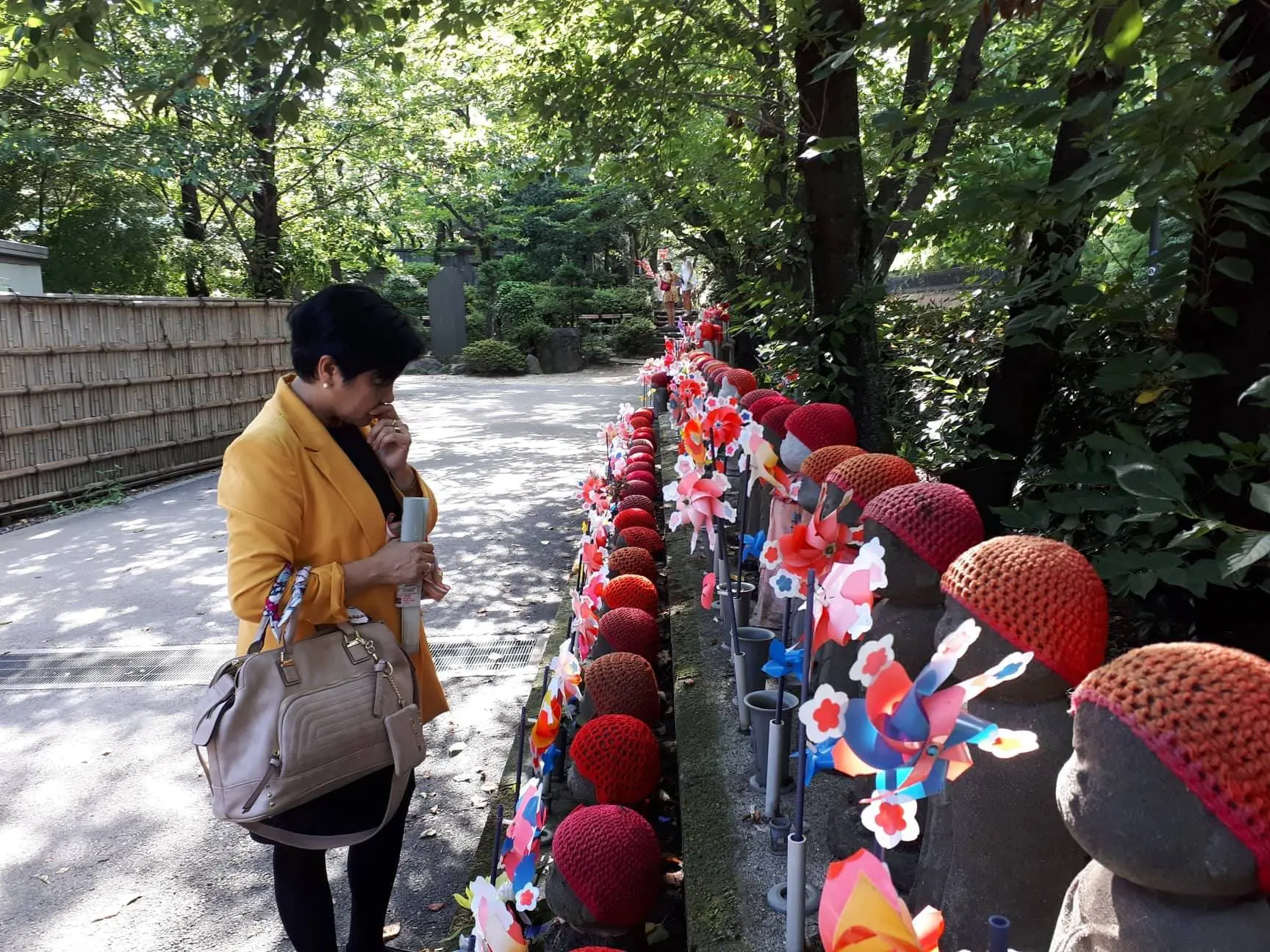
In Japan, post-War many babies were aborted after women were raped or became pregnant by whites, to “preserve the purity” of Asian blood. Here is a Shrine to the Unborn.
Nowhere is this more apparent than the United States’ population policy, which was outlined in the infamous Kissinger Report.
The Kissinger Report
In 1974, the National Security Council finalized the National Security Study Memorandum 200, commonly referred to as NSSM-200, or the Kissinger Report. The document outlined a plan to control the global population of less-developed nations to ensure U.S. political dominance.
NSSM-200 states, “The U.S. economy will require large and increasing amounts of minerals from abroad…That fact gives the U.S. enhanced interest in the political, economic, and social stability of the supplying countries. Wherever a lessening of population pressures through reduced birth rates can increase the prospects for such stability, population policy becomes relevant to resource supplies and to the economic interests of the United States.”
Essentially, the official United States’ policy proposes population reduction in developing nations to protect America’s access to natural resources.
The Kissinger Report suggested using oral contraceptives, intra-uterine devices, sterilization, injectable contraceptives, and ovulation prediction methods to reduce these populations. The document also stated, “No country has reduced its population growth without resorting to abortion.”
These are all grave affronts to human dignity. When couples use contraception, they reduce conjugal love to sexual pleasure. Children become commodities, rather than gifts from God. Sterilization mutilates men and women’s bodies and destroys the sacred gift of fertility. Abortion kills innocent, preborn children, and harms women—physically and spiritually.
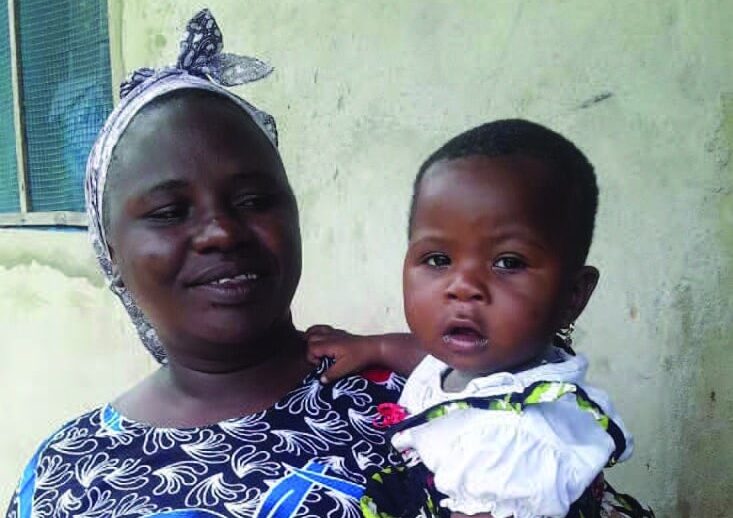
This little one is alive today because HLI missionaries taught Georgina and her husband to be open to life.
As mentioned previously, the Culture of Death views human beings as utilitarian. In NSSM-200, the government created an official policy that treats humans as disposable, rather than individuals with inherent, God-given dignity.
Organizations That Bought into the Culture of Death
We can see the fulfillment of the Kissinger Report if we look closely.
The U.S. government knew they couldn’t explicitly control the global population. This would result in a major scandal. So, the Kissinger Report passed off dirty work to non-profits such as the Pathfinder Fund, the International Planned Parenthood Foundation (IPPF) and the Population Council. These non-profits then operate through government funding.
Today, many organizations work to push abortion, contraception, and sterilization in the developing world. Their agenda expanded to include LGBTQ ideologies as well. Population groups have forcibly sterilized women, sometimes without their knowledge. This happened in Puerto Rico between 1930 and 1970. It also occurred in Peru in the 1990s, when hundreds of thousands of women were forcibly or coercively sterilized.
Forced sterilization is not limited to developing nations. Indeed, even within the United States, there is a history of sterilizing prisoners, black women, and those deemed “mentally defective.”
The US government also heavily funded the United Nations Population Fund (UNFPA), which supported the infamous Chinese population control program. As the scandal of the Chinese program spread, UNFPA tried to distance itself and deny its involvement. However, it still praised China for the program’s effectiveness.

Chinese family planning propaganda
International Planned Parenthood Federation
International Planned Parenthood Federation (IPPF) and Marie Stopes International are two of the most well-known anti-family organizations in the developing world.
IPPF’s 2022 Annual Performance Report gives a few examples of their work in the developing world:
- Sudan: IPPF lobbied for misoprostol (the second drug of the chemical abortion cocktail) to be labeled as a “National Essential Medicine” in Sudan.
- Colombia: IPPF praised Colombia for decriminalizing abortion. Abortion was previously outlawed in Colombia, but the IPPF took part in political activism to make abortion legal.
- Sub-Saharan Africa: IPPF sponsored a campaign (entitled “Treasure Your Pleasure”) encouraging young people to engage in various sexual activities including LGBTQ relationships. The report states, “Treasure Your Pleasure reached young people across the continent with fun, educational messaging on Facebook, Instagram, TikTok, Twitter and YouTube…the inclusive campaign embraced all types of pleasure for all people, regardless of their sexual orientation, gender expression or identity.”
IPPF also gave over 80 million women contraception or contraceptive counseling and performed approximately 5 million abortions (or offered pro-abortion “services”) in 2022. They also taught 35 million schoolchildren about contraception, abortion, and casual sex through online and in-person programs.
All these programs push an anti-child, anti-family mentality.
The Samoa Agreement
The Culture of Death bared its vicious teeth again in 2023, when the European Union tried to impose anti-life ideologies on 79 developing nations with the Samoa Agreement.
For years, European Union and the 79 nations of the Organization of African, Caribbean, and Pacific States have made economic—and only economic—treaties. When the previous treaty expired in 2020, ambassadors began negotiating a new agreement.
The Samoa Agreement was the result of these negotiations. Unlike previous treaties, the Samoa Agreement included a section on “human rights.” In this section, the EU demanded that the developing nations legalize abortion and LGBTQ “rights.” It would also force schools to teach the Culture of Death’s how-to manual of sexual sins—Comprehensive Sex Education.
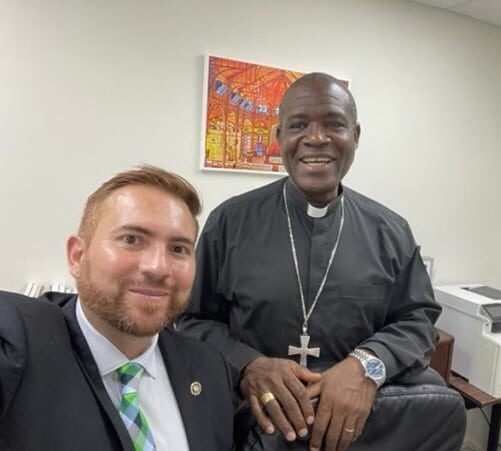
Our missionaries warned Archbishop Gordon about the dangers of the Samoa Agreement. He’ll urge government leaders to reject the treaty.
Currently, the Samoa Agreement is stalled. The EU is still waiting for countries to ratify their agreement to the treaty. HLI missionaries are working with Parliaments, urging them to reject the agreement. Please pray they are successful!
If this treaty goes into effect, it will fundamentally change the cultures of 79 nations. Most of these nations value life and family. But unchaste sex-ed, abortion, and LGBTQ ideologies would undermine the current Culture of Life in these communities.
How You Can Create a Culture of Life
To have true peace, we need to form a world where each human life is valued. To form a Culture of Life we must foster widespread respect for human dignity and support families. We also must oppose ideologies which threaten the vulnerable.
But how can we practically live out the Culture of Life every day? How can we build it in our communities?
First, we must realize just how intimately and personally God loves us. While we can never fully grasp the Father’s love, meditating on it can inspire us to share God’s love with others. When we begin seeing our neighbor as a child of God and our brother in Christ, we grow in charity and begin to be more like Christ.
We must allow Christ to act in us and transform our lives daily. If we open our hearts to Him, He will guide us and through His grace, we can begin to create a Culture of Life. Through God’s grace, our lives can show the world the goodness and the love of the Father, and through us, God can lead others to Himself.
Then, we must have a preferential option for the elderly, the suffering, the lonely, the poor, and the sick in our community. With true love of neighbor, we should approach the needy in a Christlike way and walk with them in their struggles in whatever way we are called to, showing them that they are infinitely loved and bringing them hope in God.

HLI’s affiliate, Amanda Achtman, brought hope and joy to nursing home residents who watched Mass on TV every day and who only had a Mass at their nursing home once a month. Amanda organized the “Mass of a Lifetime” with beautiful music, Adoration, and Benediction with a social afterwards with an elegant cake! The director of the nursing home was so touched that she will ensure this event happens every few months.
And when we are unable to accompany those who are in need, we must pray. We must pray for those in our community and all around the world who need to see the love of God. And we must pray for those who are accompanying the needy, such as caregivers, missionaries, and those who serve their neighbor without recognition.
Finally, we must entrust everything to Christ’s Mother and our Mother, Mary. Through her, all our human actions can be perfected and beautified for God’s delight and glory. She can see the needs of everyone in the world, and as the Mediatrix of all grace, she knows exactly who needs which graces. And if we let her, she can use our prayers, actions, and sacrifices to help those the world has forgotten and to bring them back to her Son. And because she will not be outdone in generosity, we can rest assured that she will take care of all our needs, as well.
HLI is Building a Culture of Life
Human Life International is helping to build the Culture of Life in 116 countries worldwide. Through grassroots ministry, missionaries help individuals embrace God’s plan for life and family.
HLI missionaries cultivate a Culture of Life in four crucial ways:
- Leadership Training: In order to facilitate widespread impact, HLI missionaries give influential local leaders the tools to transform their communities. These pro-life and pro-family education courses are specifically designed to equip priests, medical professionals, and other leaders to defend human dignity and promote a Culture of Life.
- Chastity Education: By helping young people embrace their God-given dignity, missionaries uproot a Culture of Death. Casual sex, contraception, and unchaste behavior violate human dignity. God has a better plan for sexuality based on selfless love and faithful marriages open to life.
- Pregnancy Care Centers: Struggling moms need holistic help. This affirms their own dignity, as well as their child’s. At these centers, HLI missionaries help moms get proper medical care, recover from trauma, reconnect with family, succeed at school, find homes and jobs, and access resources for adoption or parenting.
- Legal Activism: The Culture of Death has poisoned the laws of more than one hundred pro-family nations. That’s why HLI missionaries advocate for the protection of most vulnerable. By raising awareness about life and family issues and organizing grassroots support for pro-life policies, they’re making sure laws respect the dignity of all human beings.
Because we partner with local affiliates, HLI missionaries understand the specific cultural needs of their community. This allows our donors to make the greatest impact.
By supporting organizations like HLI, you can create a culture where every human being—from conception until natural death—is valued and protected.
The clash between the Culture of Life and the Culture of Death is real, and the struggle is playing out in communities all around the world. Thankfully, the battle is already won. Good always triumphs over evil. Today, we invite you to join the winning team.
+ Endnotes
[1] Catholic Encyclopedia [Robert Appleton Company, New York City, 1918], Volume 7, pages 1,684 to 1,696. See also the 1878 encyclical by Pope Leo XIII, Inscrutabili Dei Consilio [“On the Evils of Society”].
[2] “It is hard for many in the free world to believe that there are not only bad men, but evil men. Bad men steal, rape, ravage and plunder. Evil men may not always do these things, but they seek to destroy goodness, virtue, morality, decency, truth and honor. Bad men who steal admit honesty; evil men who do not steal call dishonesty “honesty,” totalitarianism “democracy,” slavery “freedom.” Evil men can be nice at table, polite with women, courteous in Washington, refined in London and calm in Geneva” [“Bishop Sheen Writes…Communism and Tragedy.” The Toledo Blade, Sunday, July 26, 1959, Section 2, Page 5].





